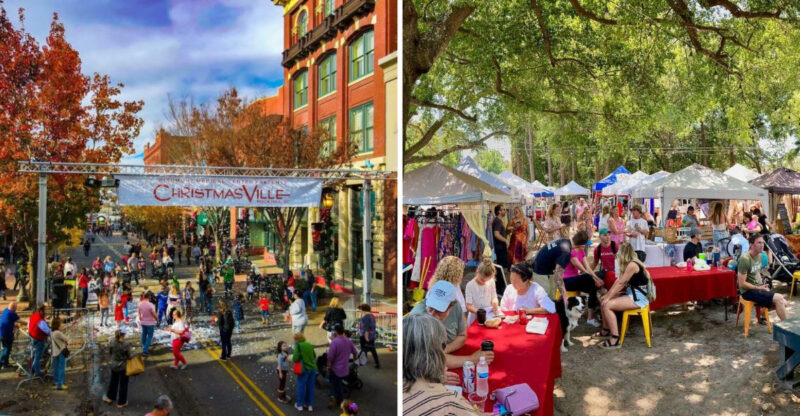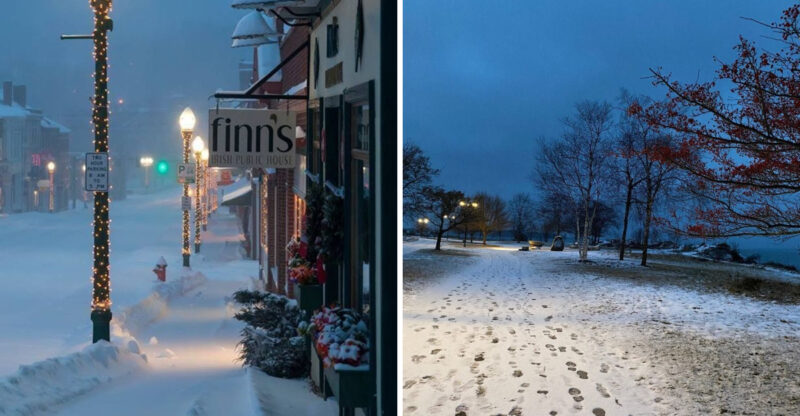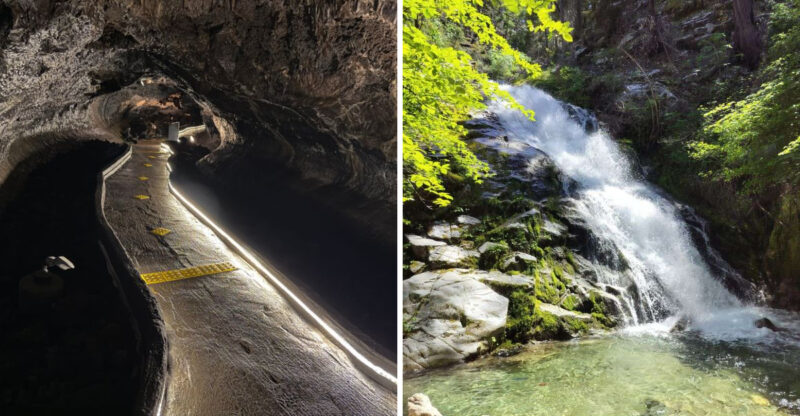Charming Views Await On Pennsylvania’s Iconic Scenic Train Through Dutch Country
Picture yourself rolling through lush farmland where horse-drawn buggies dot the landscape and historic barns stand proudly against rolling hills.
Pennsylvania’s Dutch Country offers one of America’s most enchanting train journeys, where every window frame captures a postcard-worthy moment. Whether you’re watching Amish families tend their fields or spotting wildlife in pristine valleys, this ride delivers unforgettable scenery that connects you to a simpler time.
1. Historic Red Barns and Silos
Are these iconic structures the most photographed buildings in Pennsylvania? Quite possibly! Bright red barns with white trim pop against green fields like jewels scattered across the countryside. Many date back over a century, their sturdy construction proving the craftsmanship of earlier generations.
Tall silos stand sentinel beside these barns, storing feed for livestock through harsh winters. Some barns feature decorative hex signs painted on their sides, colorful circular symbols meant to bring good fortune. You’ll see different architectural styles reflecting various waves of settlement.
Each barn tells its own story through weathered wood and careful maintenance, connecting past to present in tangible ways.
2. Horse-Drawn Buggies on Country Roads
There’s something magical about spotting a black buggy clip-clopping along beside the train tracks. Amish families travel these roads daily, their horses moving at a steady pace that contrasts sharply with our rushed modern lives. Children wave from buggy windows, their faces bright with curiosity about the passing train.
These buggies come in different styles depending on which Amish community uses them. Some are completely enclosed while others feature open sides for warmer weather. The horses themselves are beautifully groomed, clearly valued members of each family.
It’s humbling to witness transportation methods our great-grandparents would recognize instantly.
3. Traditional Amish Clotheslines
How can something as simple as laundry become so photogenic? Rows of plain-colored dresses, shirts, and trousers flapping in the breeze create surprisingly artistic displays. You’ll notice the absence of bright patterns or modern fabrics, reflecting the Amish commitment to modest simplicity.
These clotheslines appear in nearly every farmyard you pass, a reminder that Amish homes operate without electric dryers. The garments dry naturally in sunshine and fresh air, just as they have for centuries. Even in winter, you might spot frozen laundry hanging stiffly in the cold.
It’s fascinating how this everyday chore becomes a window into an entire culture’s values and lifestyle choices.
4. Pastoral Grazing Livestock Scenes
Did you know that Lancaster County produces more milk than many entire states? Herds of dairy cows graze contentedly in lush pastures throughout your journey. Black and white Holsteins are most common, though you’ll also spot brown Jersey cows and sturdy workhorses.
The animals enjoy spacious fields with plenty of shade trees and fresh water sources. Farmers rotate their livestock between pastures to keep the grass healthy and nutritious. Young calves often play together near protective mothers, their antics entertaining for passengers of all ages.
Watching these peaceful scenes reminds us where our food comes from and the hard work farming requires daily.
5. Winding Country Lanes and Covered Bridges
Though the train doesn’t cross them, you’ll spot several covered bridges from your window. These charming structures earned the nickname kissing bridges because couples could steal private moments inside them away from watchful eyes. Pennsylvania boasts more covered bridges than any other state, many built in the 1800s.
Narrow country lanes wind through the landscape, connecting farms and small communities. Stone walls line some roads, built by hand generations ago. You might see Amish children walking to their one-room schoolhouses along these peaceful byways.
Every lane seems to lead somewhere interesting, inviting exploration beyond the train ride itself.
6. One-Room Amish Schoolhouses
Keep your eyes peeled for these tiny white buildings tucked into the countryside. Amish children attend these one-room schools through eighth grade, learning from a single teacher who handles all subjects and age groups. You’ll recognize them by their simple architecture, small size, and the playground equipment out front.
During school hours, you might glimpse children playing softball or swinging during recess. The buildings lack electricity, so lessons happen by natural light streaming through large windows. Education focuses on practical skills alongside traditional subjects like reading, writing, and arithmetic.
These schools represent a commitment to community-centered education that larger districts have long abandoned.
7. Quaint Roadside Farm Stands
Colorful farm stands dot the roadside throughout your journey, their handpainted signs advertising fresh produce, baked goods, and handmade crafts. Many operate on the honor system, with customers leaving money in a box while the farmer works in distant fields. This trust-based commerce feels refreshingly old-fashioned.
Spring brings asparagus and strawberries, summer offers sweet corn and tomatoes, while fall features pumpkins and apple cider. You’ll also see signs for homemade root beer, pretzels, and the famous shoofly pie. Some stands display beautiful quilts and wooden furniture crafted by local artisans.
These stands connect farmers directly to customers, eliminating middlemen and keeping traditions alive through commerce.
8. Serene Streams and Creek Crossings
Water features add musical accompaniment to your visual feast as the train crosses several creeks and streams. These waterways once powered mills that ground grain for surrounding farms. Some still have their old millstones visible near crumbling foundations.
Willow trees drape gracefully over the banks, their branches trailing in the current. You might spot great blue herons fishing in shallow sections or turtles sunbathing on logs. The water runs clear and cold, fed by underground springs that keep it clean year-round.
When sunlight hits the water just right, it sparkles like scattered diamonds, creating moments of unexpected beauty throughout your journey.
9. Historic Stone Farmhouses
Built to last centuries, these sturdy stone homes showcase German building traditions brought by early settlers. Thick walls keep interiors cool in summer and warm in winter without modern insulation. Small windows reflect a time before glass was cheap and plentiful.
Many farmhouses feature attached summer kitchens, separate buildings where cooking happened during hot months to keep the main house comfortable. You’ll notice the homes sit close to barns for convenient access during harsh weather. Some properties include springhouses built over cold water sources for refrigeration before electricity.
These architectural treasures prove that quality craftsmanship transcends time, remaining functional after hundreds of years of continuous use.
10. Windmills Pumping Fresh Water
Tall windmills spin lazily above many farms, their blades catching breezes to pump groundwater for livestock and household use. These mechanical marvels operate without electricity, using wind power humans have harnessed for millennia. The rhythmic creaking of their gears provides soundtrack to rural life.
Some windmills are painted in cheerful colors while others wear weathered metal finishes that blend into the landscape. They typically stand near water troughs where animals gather to drink throughout the day. Engineers designed these structures so brilliantly that many operate decades after installation with minimal maintenance.
Watching them turn reminds us that sustainable technology isn’t new, just rediscovered by each generation seeking alternatives.
11. Expansive Quilted Field Patterns
From elevated sections of track, the entire valley spreads before you like a living quilt. Different crops create distinct colors and textures that farmers have arranged in geometric patterns. Corn grows tall and green, wheat ripples golden in the breeze, and tobacco leaves spread broad and dark.
This patchwork results from crop rotation, an agricultural practice that maintains soil health by varying what grows in each field annually. The patterns change with seasons, offering returning visitors completely different views. Contour farming follows the land’s natural curves, preventing erosion while creating beautiful swooping lines.
It’s agricultural art on a massive scale, practical farming that happens to be absolutely gorgeous from above.
12. Vibrant Fall Foliage Canopy
If you visit during autumn, prepare for nature’s grandest show. Maple, oak, and birch trees explode into fiery shades of orange, crimson, and gold that practically glow in the sunlight. The train passes through tunnels of color where branches arch overhead creating natural cathedral ceilings.
This region’s fall display ranks among the finest in America because the varied terrain and tree species create stunning contrasts. Evergreens provide deep green backdrops that make the autumn colors pop even more dramatically. Morning mist often clings to valleys, adding mysterious beauty to the landscape.
Bring your camera because every curve reveals another breathtaking vista worth capturing forever.
13. Rolling Amish Farmland Vistas
When you gaze out the window, acres of meticulously maintained farmland stretch as far as your eyes can see. Amish families work their fields using traditional methods that have remained unchanged for generations. You’ll notice the absence of power lines crossing these properties, making the landscape feel frozen in time.
Patchwork quilts of corn, wheat, and tobacco create a colorful tapestry across the gentle slopes. Wooden fences divide the properties in perfectly straight lines. During harvest season, you might spot families gathering crops by hand or with horse-drawn equipment.
It’s peaceful watching this lifestyle unfold before you, reminding us that simpler ways still thrive in our modern world.






